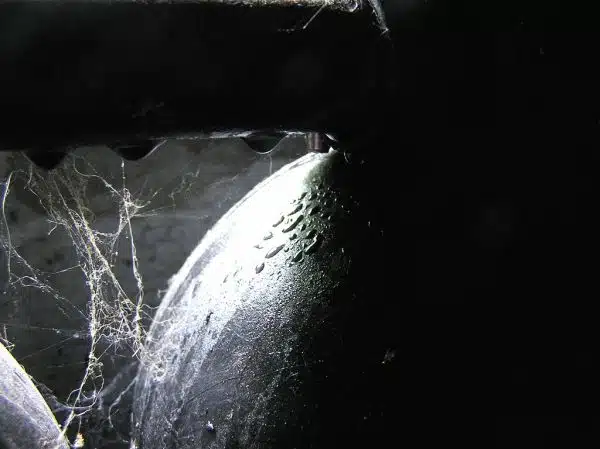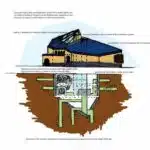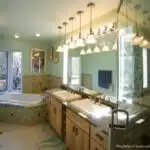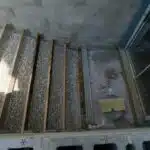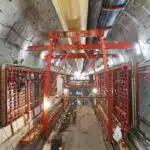Basements are an essential part of any home, providing additional living space, storage and a range of other benefits. However, they can also be prone to moisture problems such as condensation, which can lead to a host of issues such as mold growth and water damage. As an expert in basement waterproofing, it is my duty to provide homeowners with the necessary information on how to reduce basement condensation.
One of the most common causes of basement condensation is high humidity levels. This occurs when warm air meets cold surfaces, leading to the formation of water droplets. In addition to creating an uncomfortable environment for occupants, this excess moisture can also cause damage to building materials and personal belongings. Fortunately, there are several effective strategies that homeowners can employ to reduce basement condensation and maintain a healthy indoor environment. By following these simple steps, homeowners can ensure that their basements remain dry and comfortable throughout the year.
Understanding The Causes Of Basement Condensation
Basement condensation is a common problem that many homeowners face. It occurs when warm, moist air comes into contact with cooler surfaces such as walls, floors, and windows. This causes the moisture in the air to condense into water droplets on these surfaces. Understanding condensation prevention is crucial to reducing this problem.
One common misconception about basement moisture is that it only occurs during the summer months. However, this is not true as it can happen year-round. The cold temperatures during winter cause the warm air inside your home to rise and come into contact with the cooler foundation walls creating moisture buildup leading to mold, mildew or dampness issues.
Another misconception is that ventilation will solve the issue of basement condensation; although this can be helpful in some cases, it’s not always enough to eliminate the problem entirely. A more comprehensive approach includes proper insulation and waterproofing methods that will help reduce moisture buildup in your basement.
Assessing the severity of the problem requires a thorough inspection of your basement by a professional waterproofing contractor. They will look for signs of water damage on walls and floors, high humidity levels, and any sources of excess moisture. Based on their findings, they will recommend an appropriate course of action to prevent further damage or potential health hazards caused by mold growth.
With a better understanding of the causes of basement condensation and common misconceptions surrounding basement moisture, you can take necessary steps towards preventing further damage in your home. In the next section, we will explore how to assess the severity of this problem and what measures you can take to reduce its impact on your living environment.
Assessing The Severity Of The Problem
Condensation in basements can be classified into two types: bulk condensation and surface condensation. Bulk condensation occurs when warm, moist air comes into contact with a colder surface, such as a wall or the floor. Surface condensation is created when humid air comes into contact with a cold surface such as a window or a pipe. In order to reduce basement condensation, one must identify the sources of moisture, such as air leaks or high indoor humidity levels. Depending on the severity of the problem, one may need to take steps such as increasing ventilation or installing a dehumidifier.
Types Of Condensation
When you enter a damp basement, the first thing that might come to your mind is the presence of condensation. Condensation occurs when warm or humid air comes into contact with cooler surfaces such as walls and floors. This process leads to droplets of water forming on these surfaces, making them wet and slippery. There are two main types of condensation; surface and interstitial. Surface condensation occurs on the surface of walls, floors, and ceilings while interstitial condensation happens within the layers of building materials.
Surface condensation is more common in basements than interstitial because it’s easier to detect. A good way to distinguish between the two is by observing where the droplets form. In surface condensation, the droplets will be visible on external surfaces while interstitial will not show up until it has done significant damage. Moisture control is an effective method for preventing surface condensation. It involves reducing humidity levels in the basement through dehumidifiers or ventilation systems. Another prevention method is insulation which helps keep warm air from coming into contact with cool surfaces.
Interstitial condensation is a more severe issue because it can lead to mold growth and structural damage if left unchecked. Prevention methods for this type of condensation include vapor barriers, proper insulation, and adequate ventilation systems that prevent moisture from getting trapped in wall cavities or other materials used in construction. It’s important to note that different materials have different moisture absorption levels; therefore, they require different prevention methods. As a basement waterproofing expert, I would recommend consulting with a professional who can assess your specific situation and recommend appropriate moisture control and prevention methods tailored to your needs.
Identifying Sources Of Moisture
Assessing the severity of moisture problems in basements is a crucial step in determining the appropriate course of action for basement waterproofing. Identifying the sources of moisture is an essential aspect of this assessment. Moisture can come from various sources, including leaks from pipes, flooding, and high humidity levels. Determining the source helps to understand the extent of the damage caused by moisture and what measures are necessary to prevent further damage.
The first step in identifying sources of moisture is a visual inspection. This inspection includes looking for visible signs of water damage on walls, floors, and ceilings. Water stains on surfaces or mold growth are indicators that there is a water source near that area. In some cases, it may be challenging to identify the source because water can travel several feet before showing up on a surface.
In addition to visual inspections, basement waterproofing experts use specialized equipment like moisture meters to detect hidden sources of moisture behind walls and flooring materials. Such techniques help uncover slow leaks or condensation that may not be visible during initial inspections. Once all sources have been identified, appropriate moisture proofing techniques can be applied to prevent further damage and ensure long-lasting protection against future problems with dampness and mold growth in your basement.
Identifying Areas Of High Humidity
Basements are prone to high levels of humidity, which can result in the accumulation of moisture and condensation. It is crucial to identify areas where humidity levels are higher than usual to prevent water damage and mold growth. Moisture sources, such as wet laundry, leaky pipes, or standing water, can contribute to elevated humidity levels. Additionally, inadequate ventilation and poor insulation can trap moisture inside the basement.
Humidity measurement is an essential tool for identifying areas of high humidity in basements. A hygrometer can measure the relative humidity level in a space accurately. Typically, the recommended indoor relative humidity level should be between 30% and 50%. However, during winter months when outdoor air is cold and dry, it is advisable to keep the indoor relative humidity below 40% to avoid condensation on windows or other surfaces.
The most common areas of high humidity in basements include laundry rooms, bathrooms without exhaust fans, crawl spaces with exposed soil floors, and kitchens with no range hood ventilation. Once you have identified these areas of high humidity in your basement, you can take appropriate measures to minimize moisture buildup.
- Ensure proper ventilation by installing exhaust fans or opening windows
- Use a dehumidifier to remove excess moisture from the air
- Seal any cracks or gaps around windows or doors that could allow outside air and moisture into your basement.
Understanding where high-humidity areas exist within your basement is crucial in reducing condensation levels. By monitoring relative humidity levels using a hygrometer and addressing any sources of moisture build-up while employing proper insulation techniques will help reduce risks associated with excess moisture exposure. In the next section we will discuss how proper ventilation plays a critical role in maintaining healthy basement conditions.
Ventilating Your Basement
- Installing vents is a key step in reducing condensation in a basement, as it allows air to flow out of the basement and replace the moist air that is already there.
- Increasing airflow through the basement can be achieved by installing larger vents, or by adding additional vents.
- Controlling humidity levels in the basement is also important to reduce condensation.
- This can be achieved by using a dehumidifier, or by introducing an exhaust fan to remove the excess humidity.
- Regular maintenance of vents and other ventilation systems is also key to keeping condensation levels in check.
- Additionally, sealing any cracks or gaps in the basement can help prevent moist air from entering the basement, further reducing the chances of condensation.
Installing Vents
If you’re tired of seeing damp and musty walls in your basement, installing vents might be an effective solution. Proper ventilation can help regulate the humidity levels in your basement and prevent condensation buildup. However, before rushing into this project, it’s essential to weigh the pros and cons of installing vents.
One advantage of installing vents is that they allow for better air circulation, which helps eliminate moisture buildup. This can prevent mold growth and improve indoor air quality. Additionally, vents can lower energy costs by reducing the need for dehumidifiers or air conditioning units to combat high humidity levels. On the downside, poorly installed vents can invite pests like mice or insects into your home. Moreover, if not adequately insulated, vents can cause heat loss in winter.
If you decide to install vents in your basement yourself, there are a few DIY tips you should keep in mind. First, choose a location that allows for maximum airflow without compromising safety or privacy. Next, make sure the vent size is appropriate for your space and matches the existing ductwork system’s dimensions. Finally, use weather-resistant materials like PVC or aluminum to prevent corrosion over time.
In conclusion, proper ventilation is a critical aspect of preventing condensation buildup in basements. Installing vents can be an effective solution but requires careful consideration of its pros and cons before proceeding with the project. If you choose to go the DIY route when installing vents, following these tips will ensure a safe and successful installation process.
Increasing Airflow
As a basement waterproofing expert, I highly recommend increasing airflow in your basement to prevent moisture buildup and condensation. Proper ventilation can provide numerous benefits for your home, including improved indoor air quality and reduced energy costs. By increasing airflow, you can prevent mold growth and keep your basement dry and comfortable.
One of the significant benefits of increasing airflow is that it helps regulate humidity levels in your basement. This can prevent musty odors and dampness from developing, making your basement a more pleasant space to spend time in. Additionally, proper ventilation can help reduce the risk of respiratory problems caused by airborne pollutants like mold spores or dust mites.
To improve ventilation in your basement, there are a few tips you should follow. First, consider installing exhaust fans or vents to increase airflow. These can be installed in windows or walls to allow fresh air to circulate into your basement while pushing stale air out. Second, make sure any cracks or gaps around windows or doors are sealed with weatherstripping to prevent unwanted drafts. Finally, ensure that any appliances like dryers or furnaces are adequately vented outside to avoid adding moisture to the air inside your home.
Improving airflow is an essential step in preventing moisture buildup and maintaining good indoor air quality in your basement. By following these tips for improving ventilation, you can create a healthy living environment for you and your family while enjoying the benefits of a dry and comfortable space.
Controlling Humidity
Proper ventilation is crucial in keeping your basement dry and comfortable. As a basement waterproofing expert, I highly recommend improving airflow to prevent moisture buildup and condensation. In this subtopic, we will discuss the importance of controlling humidity levels in your basement and the methods you can use to achieve this.
Humidity control is essential in preventing mold growth, musty odors, and dampness in your basement. The level of humidity in your basement can be affected by weather conditions outside; for example, during hot and humid days, more moisture can enter your home. To control humidity levels, consider using a dehumidifier or air conditioner. Dehumidifiers work by removing excess moisture from the air, while air conditioners help reduce humidity levels by cooling and drying out the air.
There are other methods you can use to control humidity levels in your basement. These include sealing any cracks or gaps in walls or floors to prevent moisture from entering your home. Installing a sump pump system can also be beneficial as it helps remove excess water from your basement before it causes damage. Overall, controlling humidity levels is critical for maintaining good indoor air quality and preventing damage to your home caused by moisture buildup.
Installing Dehumidifiers
Picture this: You’ve been working hard on your basement renovation for weeks, but the constant dampness and condensation leaves you feeling defeated. The good news is that a dehumidifier can be your knight in shining armor. It’s not just any ordinary appliance; it’s the hero that saves your basement from moisture damage.
To get the most out of your dehumidifier, proper maintenance is key. Cleaning and replacing filters regularly ensures optimal performance, while emptying the water tank prevents mold growth and funky odors. Additionally, choosing the right dehumidifier for your space is crucial. Factors such as room size and humidity levels should be taken into consideration to determine the appropriate capacity needed.
As a basement waterproofing expert, I can attest to the effectiveness of using a dehumidifier to combat basement condensation. However, it’s important to remember that it’s not a one-and-done solution. Dehumidifier maintenance and selecting the right unit are essential elements in keeping your basement dry and healthy. Next up, we’ll dive into sealing basement cracks and leaks to further protect against moisture intrusion.
Sealing Basement Cracks And Leaks
After installing a dehumidifier, it is essential to identify and fix any leaks in your basement. Fixing leaks is the first step in reducing basement condensation. Leaks can occur through cracks in the walls or floors of your basement. These cracks allow moisture to seep into the basement, leading to mold growth and increased humidity levels.
Waterproofing solutions are an effective way to prevent water from entering your basement. Waterproofing solutions can be applied both internally and externally to prevent water from entering your home. External waterproofing solutions involve excavating around the foundation of your home and applying a waterproof membrane. Internal waterproofing solutions involve installing drainage systems that direct water away from the foundation of your home.
In addition to fixing leaks and applying waterproofing solutions, insulating pipes and ducts can also help reduce basement condensation. Pipes and ducts that run through unconditioned spaces such as basements are prone to sweating due to temperature differences between the cold surfaces of the pipes/ducts and warm air surrounding them. Insulating these surfaces can help prevent condensation buildup, reducing the risk of mold growth.
By fixing leaks, applying waterproofing solutions, and insulating pipes and ducts, you can effectively reduce basement condensation. These steps not only improve indoor air quality but also protect your home from structural damage caused by moisture buildup.
Insulating Pipes And Ducts
Preventing corrosion is essential to ensuring the longevity of your pipes and ducts. Moisture can cause metal pipes and ducts to corrode, leading to leaks and costly repairs. By insulating your pipes and ducts, you can prevent moisture from building up on the surface of these materials, which reduces the risk of corrosion.
Energy efficient insulation is another critical aspect of reducing basement condensation. Poor insulation can lead to temperature fluctuations that create moisture in the air, which may lead to condensation forming on surfaces such as pipes and ducts. When choosing insulation for your basement, it’s essential to consider energy efficiency. High-quality insulation will help regulate the temperature in your basement while also preventing moisture buildup.
In addition to preventing corrosion and promoting energy efficiency, insulating pipes and ducts can provide additional benefits such as reducing noise levels and improving indoor air quality. Insulated pipes and ducts are less likely to rattle or vibrate, making them less noisy during operation. Furthermore, proper insulation helps prevent mold growth by reducing excess moisture in the air. By insulating your pipes and ducts, you can ensure a healthier living environment for you and your family.
By properly insulating your pipes and ducts, you can significantly reduce the amount of condensation in your basement. However, it’s important not to overlook other potential sources of moisture in the area. Checking your home’s drainage system is an essential next step in mitigating any further water damage or problems associated with dampness in basements.
Checking Your Home’s Drainage System
Now that we have learned about insulating pipes and ducts, let’s move on to the next step in reducing basement condensation – checking your home’s drainage system. A poor drainage system can cause water to accumulate around the foundation of your home, leading to moisture buildup in the basement. This is why it is important to regularly check your gutters and downspouts for any blockages or damage.
To ensure a properly functioning drainage system, here are some steps you can take:
- Clean out gutters and downspouts regularly to prevent any debris buildup.
- Install gutter guards to prevent leaves and other debris from clogging up the gutters.
- Check for any damage or leaks in your gutters and downspouts and repair them immediately.
Another solution to reduce basement condensation is by installing a sump pump. A sump pump helps remove excess water from the basement, preventing moisture buildup. It works by collecting water from around the foundation of your home and pumping it away from the house.
When considering installing a sump pump, here are some factors to keep in mind:
- Choose a high-quality sump pump with a battery backup system in case of power outages.
- Hire a professional waterproofing contractor to install the sump pump for optimal results.
- Regularly maintain the sump pump by cleaning it out and testing its functionality.
By following these steps, you can effectively reduce basement condensation and create a dry, comfortable living space in your home. In our next section, we will discuss using moisture-resistant materials as another solution for preventing moisture buildup.
Using Moisture-Resistant Materials
- To prevent condensation in basements, sealing the walls and floors with a waterproof sealant is essential.
- A vapor barrier should also be applied to prevent moisture from entering the basement from the outside.
- Moisture-resistant materials such as latex, acrylic, and urethane can be used to effectively seal the basement from moisture.
- When selecting moisture-resistant materials, it is important to consider the cost, durability, and compatibility with the existing structure.
Using Sealants
One effective way to reduce basement condensation is by using sealants. Sealants can prevent moisture from entering the basement through cracks or gaps in walls and floors. They create a barrier that blocks out water and prevents it from seeping into the foundation of the house. This can significantly reduce the amount of moisture in the basement, which in turn helps to reduce condensation.
There are different types of sealants available, each with their own unique benefits. One popular option is silicone sealant, which is known for its durability and resistance to water. It forms a strong bond with surfaces and can be used on both interior and exterior surfaces. Another option is polyurethane sealant, which is also highly resistant to water and has excellent adhesion properties. It is commonly used for sealing joints or gaps between concrete slabs.
The benefits of using sealants go beyond reducing basement condensation. They can also help to prevent mold growth, improve indoor air quality, and protect your home from water damage. By creating a barrier that blocks out moisture, you can ensure that your basement remains dry and comfortable all year round. With so many different types of sealants available, it’s important to choose one that is appropriate for your specific needs and budget.
Using Vapor Barriers
Another effective way to combat basement condensation is by using vapor barriers. A vapor barrier is a moisture-resistant material that prevents water vapor from penetrating through walls and floors. These barriers can be installed on the interior or exterior of the foundation walls, depending on the specific needs of your home. The installation process involves covering the walls with a layer of plastic sheeting or other moisture-resistant materials.
The benefits of using vapor barriers are numerous. They not only reduce basement condensation but also prevent mold growth and protect your home from water damage. Additionally, they improve indoor air quality by preventing the buildup of harmful pollutants and allergens. Vapor barriers are an affordable and effective way to keep your basement dry and comfortable all year round.
When it comes to choosing a vapor barrier, it’s important to work with a professional who has experience in basement waterproofing. They can help you select the best materials for your specific needs and ensure that they are installed properly. By investing in a high-quality vapor barrier, you can enjoy all the benefits of a dry, healthy basement for years to come.
Storing Belongings Properly
Proper ventilation is crucial in reducing basement condensation. It helps to maintain a balanced level of moisture by allowing air to circulate freely. There are several ways to improve ventilation in your basement, such as installing exhaust fans or opening windows whenever possible. Dehumidifiers are also an excellent investment for those who live in humid climates.
Organizational tips can also help reduce basement condensation. By keeping your belongings off the floor and away from walls, you can prevent moisture from seeping into them. Shelving units can be used to store items that are not often used, while plastic bins with airtight lids are great for storing seasonal items like clothes and decorations.
By following these tips, you can significantly reduce basement condensation and keep your belongings safe from damage. Proper ventilation and organization go hand-in-hand when it comes to maintaining a healthy environment in your home’s lower level. In the next section, we will discuss the importance of cleaning and maintaining your basement regularly to ensure that it remains dry and free of damage-causing mold and mildew.
Cleaning And Maintaining Your Basement Regularly
Imagine your basement as a forest floor. Over time, leaves and debris accumulate, creating an environment that fosters mold growth and attracts insects. Similarly, in your basement, clutter can lead to moisture buildup and unwanted growths like mildew and mold. By regularly cleaning and maintaining your basement, you can reduce the likelihood of these issues arising.
One of the benefits of decluttering is that it allows for better airflow throughout the space. When items are stacked or stored too closely together, air cannot circulate freely. This can cause humidity to build up in certain areas of the room, leading to condensation on walls and floors. By removing unnecessary items and organizing what remains, you allow air to flow more easily through the space.
In addition to decluttering, there are several tips for organizing your basement that can help prevent condensation. For example, store items off of concrete floors by using shelving or pallets. This helps prevent moisture from seeping into boxes or furniture placed directly on the ground. Additionally, make sure any appliances or equipment in the basement are properly ventilated to avoid excess humidity buildup.
To take further steps towards reducing condensation in your basement, seeking professional assistance may be necessary. A waterproofing expert can assess your specific situation and recommend appropriate solutions such as installing a dehumidifier or sealing cracks in walls or floors. By taking preventative measures and investing in professional assistance when needed, you can create a dry and healthy environment for your home’s foundation.
Seeking Professional Assistance
After cleaning and maintaining your basement regularly, you may still face issues such as condensation. If this is the case, it may be time to consider seeking professional assistance. Hiring professionals can save you time and money in the long run, as they have the experience and tools necessary to address the issue effectively.
When considering hiring professionals for basement waterproofing, it’s important to factor in the cost of assistance. While it may seem costly upfront, investing in proper waterproofing can prevent costly damage to your home down the line. Additionally, many companies offer financing options or payment plans to make their services more accessible.
By hiring professionals, you’ll not only address any current condensation problems but also prevent future ones. Waterproofing experts can identify potential issues and provide solutions before they become major problems. Overall, seeking professional assistance is a wise investment in protecting your home from water damage and ensuring a safe living environment for you and your family.
To prevent future condensation problems, it’s important to address any underlying causes of moisture in your home. This may include improving ventilation, sealing any cracks or gaps where water could enter, and properly insulating pipes or ductwork. By taking these preventative steps and regularly monitoring your basement for signs of moisture buildup, you can ensure a dry and healthy living space for years to come.
Preventing Future Condensation Problems
Did you know that 98% of basements are susceptible to moisture problems? This is a staggering statistic that highlights the need for homeowners to take measures to prevent future condensation problems. The good news is that there are several basement insulation and moisture proofing techniques that can be employed to avoid costly repairs down the road.
First, it is important to ensure proper ventilation in your basement. This can be achieved by installing vents or exhaust fans which will help circulate air and prevent stagnant moisture from accumulating. Additionally, sealing any cracks or gaps in your foundation walls will help prevent water infiltration, which can lead to condensation problems.
Secondly, consider investing in a dehumidifier. These devices work by removing excess humidity from the air and preventing mold growth. Be sure to choose a model with sufficient capacity for your basement size and run it regularly during humid months.
Thirdly, check the grading around your home’s foundation. If the ground slopes towards your house, this can cause water to pool near the foundation and increase moisture levels in your basement. Ensure that the ground slopes away from your house by filling in low spots with soil.
Lastly, employ proper insulation techniques such as using closed-cell foam insulation which resists moisture intrusion and won’t absorb water like traditional fiberglass insulation. By taking these preventative measures, you’ll save money on costly repairs down the line and enjoy a dry and comfortable living space.
To further prevent future condensation problems, it is important to monitor humidity levels in your basement regularly. This will allow you to identify any potential issues before they become major problems.
Monitoring Humidity Levels
To continue preventing future condensation problems, it is essential to monitor humidity levels in the basement. Humidity levels that exceed 60% can lead to moisture buildup, which contributes to condensation problems. One of the best practices for monitoring humidity is using a hygrometer, a device that measures the level of moisture in the air.
Using a dehumidifier is one of the best ways to reduce basement condensation. Dehumidifiers work by removing excess moisture from the air, preventing it from building up and causing condensation on walls and floors. The benefits of dehumidifiers go beyond reducing condensation; they also improve indoor air quality by eliminating musty odors, mold growth, and other allergens.
To get the most out of your dehumidifier, it’s crucial to follow some best practices for optimal performance. First, ensure that your dehumidifier is appropriately sized for your space; an undersized unit won’t be able to keep up with moisture levels, while an oversized unit will consume more energy than necessary. Additionally, clean or replace filters regularly and empty water collection trays frequently to prevent bacteria growth and other contaminants from spreading.
By monitoring humidity levels and using a dehumidifier correctly, you can enjoy a dry and comfortable basement free from condensation problems. Remember that prevention is key; early intervention can save you time and money down the road by avoiding costly repairs associated with water damage.
Enjoying A Dry And Comfortable Basement
A dry and comfortable basement is like a breath of fresh air. It’s an oasis in your home where you can unwind, relax, and enjoy the peace and quiet. However, basement condensation can make this dream seem impossible to achieve. Fortunately, there are ways to reduce basement condensation and create a dry and comfortable living space.
Basement waterproofing is the first step towards a dry basement. When water seeps through the walls or foundation, it creates a damp environment that encourages mold growth. A professional waterproofing company can help seal any cracks or gaps in your foundation, preventing water from entering your basement. This will not only reduce condensation but also prevent more severe water damage.
Air circulation is another critical factor in reducing basement condensation. Poor ventilation leads to stagnant air that traps moisture, leading to mold growth and foul odors. Installing an air exchange system or dehumidifier can promote proper airflow by removing excess moisture from the air. It’s important to maintain proper humidity levels between 30-50% to avoid any potential health hazards.
To enjoy a dry and comfortable basement, there are several key factors to consider:
- Proper waterproofing measures
- Adequate ventilation
- Sealing any cracks or gaps in your foundation
- Maintaining proper humidity levels
- Regularly cleaning gutters and downspouts
By following these tips, you’ll be able to enjoy a healthy living space free from the negative effects of excessive moisture and humidity. Remember that prevention is always better than cure when it comes to maintaining a dry basement.
Conclusion
Basement condensation can be a frustrating and potentially damaging problem for homeowners. Understanding the causes of this issue is the first step in finding a solution. Once the severity of the problem has been assessed, identifying areas of high humidity and implementing proper ventilation techniques can help reduce basement moisture levels. Installing dehumidifiers and seeking professional assistance may also be necessary to effectively combat condensation.
Preventing future condensation problems involves monitoring humidity levels and addressing any potential sources of moisture, such as leaky pipes or cracks in the foundation. With proper maintenance and attention to detail, a dry and comfortable basement can be achieved.
One example that evokes an emotional response is that of a family who discovered mold growing in their basement due to excess condensation. The mold not only posed health risks but also caused significant damage to their property. By taking steps to reduce basement moisture levels, they were able to eliminate the mold and create a safe living environment for themselves and their children. Don’t let basement condensation cause problems for you and your family – take action today!
Image Credits
- “webs, condensation on basement water tank” by Muffet (featured)

